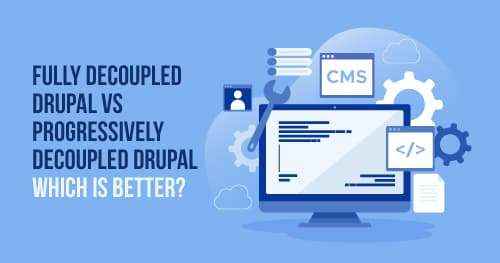
Fully Decoupled Vs Progressively Decoupled Drupal: Which Is Better
Content is the king and is the reason which attracts the customer's attention towards your website. But do not forget that your website content should be highly responsive to reach the desired goal. So, people are moving towards the decoupled approach to building a highly responsive website.
There are two decoupled Drupal types: progressively decoupled and fully decoupled. So, in this article, we will study these two approaches.
Fully Decoupled Drupal
Fully Decoupled Drupal is all about the complete separation of the presentation layer and other aspects of the CMS. In this approach, a JavaScript application or static site generator deals with Drupal with the help of service APIs where CMS becomes a data provider.
Yes, there is no doubt that you will find fewer features and functionalities of editing and layout management. But still, Fully decoupled Drupal is one of the best options for developers looking for the best control over the front end. And people who are already well experienced with building applications in frameworks such as Angular, React, Gatsby etc.
Fully Decoupled App
Fully decoupled applications are made with the frameworks like Angular, React, Vue.js and are usually programmed in JavaScript programming language.
React
Source: W3Techs
React is one of the most famous libraries of the JavaScript programming language, which was brought to light in the year 2013. This framework is beneficial for creating user interfaces as we know that it is one of the most popular and well-renowned programming languages. High tech giants like Facebook manage this programming language.
React is capable of splitting codes into different parts. This helps the developers to use those codes in other programming and debugging. Since the code style of React is very descriptive, this is the reason it has become one of the most famous and popular programming languages.
Moreover, React is known for high-quality libraries and conferences. This is why it is becoming the first demand of developers. BBC, New York Times, Facebook, Reddit and Airbnb etc., are some of the well-known web applications that use React as their first choice.
Most technology companies find that the combination of React and Drupal is making some good digital experiences. Also, the one-way data flow of React allows shaping the web page as per the data which is sent from Drupal's RESTful API. Read more about the combination of Drupal and react here.
Angular
Source: W3Techs
Another famous framework of JavaScript is Angular which is considered the most lightweight and concise framework that is highly flexible for making your website the best for exciting stuff. For example, Angular can extend HTML to define the user interface. Apart from this, Angular helps you to create impressive web applications.
AngularJS can create reusable components, and due to its client-side nature, there are no chances of cyber-attacks. In addition, there are several features that you can see in the Angular framework, such as MVC (Model-View-Controller) framework enabling a faster development process, multiple views, asynchronous technique, and SEO friendly development.
Vue
Source: W3Techs
Vue.js is yet another famous JavaScript framework known for developing interactive applications. It can provide data-reactive components with an easy and flexible API. This framework is used as a library to add excellent elements to existing sites. Vue.js helps you to deliver an instant boost to the user experience.
With the help of the official Vue-Resource plugin, developers could request and store Drupal content as data objects. This becomes possible only with the combination of Drupal and Vue.js. The combination of Drupal and Vue.js works like magic both for the frontend and backend. For example, Drupal is enabled to show its magic at the backend while the attractive features of Vue look after the client-side.
Well, apart from these features, the components of Vue.js are another most vital feature that helps build large-scale web applications that cover all small businesses and entrepreneurs.
Progressively Decoupled Drupal
Progressively decoupled Drupal talks about the architectural approach through which website editors become able to edit and modify the changes related to leveraging the administrative interfaces, content workflows, and all other traditional processes of creating, editing, and publishing content through Drupal.
Progressively decoupled Drupal builds an excellent balance and is a communication bridge between the editorial and developer requirements. This is done by enabling editors and website assemblers for contextualized interfaces, content workflow, website preview, and other essential features to remain integrated with Drupal.
Additionally, the frontend developers have distributed a page piece to incorporate the frontend system fitting their personal preference, React, Angular, or Gatsby, by this architectural approach. This cycle for sure aids the front-end developers by eliminating the limitations of Drupal's templating framework.
A Quick Overview
In a nutshell, progressively decoupling obscures the thin line between the back and front end rather than completely decoupling the two. Doing so permits you to use Drupal's rendering system, alongside the synchronous utilization of JavaScript structures like React and Angular, to give intuitive client encounters.
Accordingly, using this design, one can keep up with client-side interactivity to make a more rich user experience.
What Should You Choose?
Now you are fully aware of both Fully Decoupled and Progressively Decoupled Drupal. So, I can say that if your requirements are editorial, then there is no fun to go with the Fully Decoupled. On the other hand, you should not go with the Progressively Decoupled Drupal if your project is total.
Have a look at the below-given image, which shows a sharp difference between Fully Decoupled Drupal and Progressively Decoupled Drupal.





